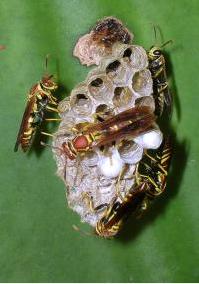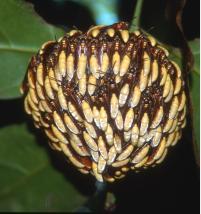Wasps with bigger brains evolve social networking
April 12, 2011

Wasps in the species Polistes instabilis form small, simple colonies of a few dozen adults (credit: Sean O'Donnell, U. Washington)
Neurobiologists at the University of Washington have found that bigger-bodied social wasps have larger brains and devote up to three times more of their brain tissue to regions that coordinate social interactions, learning, memory, and other complex behaviors.
The researchers dissected wasp brains and measured the volume of two brain regions. They focused on the central processing region (the mushroom bodies) that, like the cerebral cortex in humans, handles elaborate cognitive functions such as learning, memory and social interactions. They also measured the peripheral processing regions (the optic lobes and the antenna lobes), which deal with vision and smell and are thought to perform more basic cognitive functions.

Apoica pallens wasps at their nest in the afternoon. The species is nocturnal --- unusual for social wasps --- and foragers hunt at night (credit: Sean O'Donnell, U. Washington)
Across the 10 species dissected, the wasps with larger bodies and correspondingly larger-sized brains, such as social wasp queens, had disproportionately larger central processing regions. The researchers said that the greater brain power possessed by queens may be due to having to defend their social status.
The research showed that there is a minimum necessary investment in peripheral sensory processing brain tissue, with little to gain from additional investment. In contrast, increased brain size provides additional higher-order cognitive processing tissue.
Ref.: Sean O’Donnell et al., Comparative analysis of constraints and caste differences in brain investment among social paper wasps, April 11 online edition, PNAS